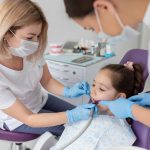
Blood Cancer in Children – Symptoms, Diagnosis, and Treatment by Dr. Stalin Ramprakash
9 min readWritten by Editorial Team


The month of September is celebrated as blood cancer awareness month. The year 2021 has seen many cases of cancer, mostly leukemia, that impact the blood-forming cells in the body. Leukemia is a form of “blood cancer” and it is the most common form of blood cancer in children. Other types of blood cancer impact children too.
Blood cancers in children develop due to the abnormal growth of blood cells. This often-uncontrollable growth of blood cells disrupts the activities of normal blood cells, especially the production of new blood cells. There is plenty of misinformation about blood cancer in children. This lack of accurate awareness makes parents feel helpless. As long as blood cancers in children are given immediate attention, these diseases can be managed. Chemotherapy and other forms of long-term treatments can give children second chances. To honor 2021’s blood cancer awareness month, let’s learn all about blood cancers in children.
In This Article
- Types of Blood Cancer in Children
- Signs and Symptoms of Blood Cancer in Children
- Causes of Blood Cancer in Children
- Risk Factors For Blood Cancer in Children
- Diagnosing Blood Cancer in Children
- How Can Parents Prepare Their Child For a Cancer Test?
- Stages of Blood Cancer in Children
- Blood Cancer Treatment in Children
- Rehabilitation After Treatment
- Preventing Blood Cancer in Children
- FAQ’s
Types of Blood Cancer in Children
Blood cancer in children is very rare. Leukemia, a cancer of the bone marrow, is the most common form. Here are all the types of blood cancer in children:
1. Leukemia
Bone marrow is a tissue where blood is made. It is present inside many bones in our bodies. Children with leukemia experience overgrowth of “leukemic” cells in their bone marrow. These undeveloped cells crowd narrow bone marrow spaces, preventing the production of platelets, red blood cells, and white blood cells.
There are two types of childhood leukemia
a) Acute Lymphocytic Leukemia (ALL)
Approximately 80% of all children with leukemia have ALL. Children aged 3-5 are at the highest risk for this type of cancer. ALL results in the overproduction of “leukemic” white blood cells.
b) Acute Myeloid Leukemia (AML)
This form of leukemia develops rapidly, so thankfully, it doesn’t affect many children. Children with AML experience severe drops in the number of healthy blood cells in their bloodstreams – all three types. AML develops in the bloodstream’s myeloid cells. It has been linked with exposure to high amounts of radiation.
Chronic Lymphocytic Leukemia is another form of leukemia, but it mainly affects older adults.
2. Lymphoma
This form of cancer starts in white blood cells (WBCs). WBCs are also called lymphocytes. The two types of lymphoma affect the child’s lymph nodes, spleen, and thymus glands – i.e., their lymph systems. The lymph system struggles to do its task (help the body fight infections) because the network of vessels that carry the WBCs is damaged.
The two types of lymphoma that affect children are
- Hodgkin Lymphoma (i.e., Hodgkin disease)
- Non-Hodgkin Lymphoma
Some other non-blood cancers that affect children and teenagers include – Osteosarcoma, Ewing Sarcoma, Neuroblastoma, Retinoblastoma, Nephroblastoma, and Rhabdomyosarcoma.
Signs and Symptoms of Blood Cancer in Children

Children experience symptoms of blood cancer because of the decrease in the production of normal blood cells in their bodies. When children’s RBC and WBC counts lower, they become pale, fatigued, anemic, and become prone to constant infections, fevers, etc. The decrease in platelet production may also lead to bleeding problems like nosebleeds or frequent cuts.
Some other symptoms of blood cancer in children include:
- Bone pain. The child may be tender to the touch on bones, spleen, and muscles.
- Red spots on the skin due to the bleeding of tiny blood vessels.
- Abnormally low platelet counts in blood tests.
- Stomachaches due to leukemia cells accumulating in the liver, kidneys, and spleen.
- Lack of appetite due to the abnormal enlargement of the liver, kidneys, and spleen.
- Weight loss.
- Respiratory issues like the inability to breathe properly (dyspnea) as leukemic cells cluster around the neck.
- Prolonged bouts of infections (viral and bacterial) such as running nose, persistent coughing, and fever.
- Lack of response to antibiotics, organic treatments, or other treatments.
- Swelling in the groin, around the neck (collarbone region), or under the child’s arms due to swollen lymph nodes.
- RBCs are unable to pass through overcrowded bone marrows to distribute healthy amounts of oxygen throughout the body.
- Slurred speech as reductions in blood flow to the brain causes it to malfunction.
[Read : Anemia in Children]
Causes of Blood Cancer in Children
The exact causes of most blood cancers in children are not known. However, scientists have noted that changes in the “normal” bone marrow cells’ DNA cause the uncontrollable growth of cancerous cells. These cells become leukemia cells. The DNA inside these cells goes out of control, impacting the child’s blood cell functioning.
Some common causes of blood cancer in children include
1. Inherited Gene Mutations
Some children receive DNA mutations from their parent/s. For instance, an inherited mutation called the “TP53 tumor-suppressor gene” increases a child’s risk of different types of blood cancers.
2. Acquired Gene Mutations
Many DNA mutations linked with blood cancers develop long after conception. Some of these mutations develop right before birth. Children with exposure to cancer-causing radiation or chemicals may also develop leukemia and other types of blood cancers.
Some studies have suggested that childhood blood cancers are caused by a combination of inherited and acquired gene changes. Most of these gene changes occur early in life. If a child is exposed to bacterial or viral diseases during this period, they may develop childhood leukemia.
Some other suspected causes of blood cancers in children include:
1. Inherited Immune System Deficiencies
Many children inherit immune system conditions such as Schwachman-Diamond syndrome, Bloom syndrome, etc., from their parents. These immuno-deficiencies increase their risks of getting leukemia and other serious blood infections.
2. Artificial Immune System Suppression
When children undergo intensive treatment (not for cancer), their immune systems are repressed. For instance, a child undergoing an organ transplant is at high risk of developing lymphoma or Acute Lymphocytic Leukemia.
3. Siblings with Leukemia
The risk of siblings developing leukemia is high, especially if the disease develops in one sibling’s first year of life. Identical twins (one twin develops blood cancer) face higher risks.
4. Lifestyle-Related Issues
Parents with cancers, smoking/alcohol addictions, and excessive sun exposure are likelier to have children with blood cancers. Many studies have linked pregnant women drinking alcohol or smoking during pregnancy with increased blood cancer risks for their children.
5. External Risks
External risk factors such as extensive exposure to radiation or cancer-causing chemicals put children at increased risks. Exposure to chemotherapy drugs (e.g., cyclophosphamide or etoposide), benzene, and pesticides in early childhood may also increase blood cancer risks.
Researchers continue to study these suspected causes of blood cancer in children. A combination of many of these factors may be the ultimate cause of blood cancers in children.
Risk Factors For Blood Cancer in Children
The only major risk factor for blood cancer in children is genetic. Many genetic risk factors of blood cancer are inherited from parents. For example, children who’ve inherited down syndrome (trisomy 21) are likelier to develop leukemia (AML and ALL). Similarly, Li-Fraumeni syndrome, another inherited condition, puts kids at higher risks of developing blood cancers.
Diagnosing Blood Cancer in Children

Diagnosis of blood cancers in children depends on various factors. They include:
- The type of blood cancer suspected
- The child’s signs and symptoms; severity of symptoms
- The child’s age
- Pre-existing medical conditions
- Results of medical tests
Diagnosis of any cancer in children is a difficult process for parents. But, these difficult journeys can only begin when parents take their children (with cancer symptoms) to professional doctors. The earliest symptoms of childhood blood cancers are very similar to common childhood illnesses/injuries.
Doctors may order the following tests to clear their suspicions:
- Blood count tests
- Blood chemistry tests
- Urine tests
- Imaging tests (X-rays, Magnetic Resonance Imaging tests, ultrasound tests, or Computed Tomography)
- Lumbar puncture (bone marrow biopsy to take bone marrow samples and examine the presence of cancerous cells)
- Additional blood tests to review blood chemical levels
- Liver and kidney tests
- Genetic tests
Once the lab tests return, the child’s medical team will review report details to create customized treatment plans. These reports are known as “pathology reports.” They detail the child’s diagnosis and treatment plans.
How Can Parents Prepare Their Child For a Cancer Test?
Parents can ask the care team the following types of questions before putting their child through physical tests.
- What are the risks my child is facing because of these tests?
- Are pain-numbing medications necessary to reduce discomfort/pain during the tests?
- How should my child prepare?
- How will test results impact the treatment plans?
- What are the reasons behind each test prescribed by the doctor?
The care team will complete the physical exams and review’s the child’s medical history and pathology reports. They may recommend the following medical tests, depending on the type of blood cancer they suspect the child has –
1. Leukemia
Children with leukemia must go through complete blood count (CBC) tests. CBC test reports inform doctors about abnormal levels of platelets, WBCs, or RBCs.
2. Lymphoma
Children suspected to have lymphoma may have to undergo a lymph biopsy. Surgeons remove small portions of tissues, examine them under microscopes to detect the severity of the condition. Doctors may also ask for PET scans, or CT scans to detect abnormally sized lymph nodes.
3. Myeloma
For children suspected to have myeloma, doctors recommend CBC tests, blood tests, urine tests, X-rays, PET, and MRI scans. These tests reveal the presence of chemicals that are released due to myeloma growth in the bloodstream.
Stages of Blood Cancer in Children
Unlike other types of cancers, blood cancers in children are typically not divided into stages. Instead, children are categorized as per the immediate risks they face for the types of blood cancer they have. The risk levels for children with blood cancers depend on:
- The type of blood cancer
- How the cancer is expected to progress
- How developed the cancerous growths are
- Genetics
- How well the child can endure the treatments
- The child’s medical history and present health
- The child’s age
Blood Cancer Treatment in Children

Treatment of blood cancers in children starts with doctors taking care of the initial symptoms (e.g., anemia, excessive bleeding, etc.) Treatment of most children with ALL (Acute Lymphocytic Leukemia) or AML (Acute Myeloid Leukemia) is typically divided into three phases:
1. Induction
In this phase, doctors take steps to kill the cancer cells in the child’s bloodstream or bone marrow.
2. Consolidation
Also known as intensification, this stage of blood cancer treatment aims at preventing the regeneration of cancer cells.
3. Maintenance
Because of the intensity of the first two stages of treatment, children need to be in constant care. Or else they risk getting unnecessary complications. Maintenance of children with ALL, AML, and other types of blood cancer takes place in cancer centers.
These treatments typically last for 2-3 years, with the most difficult treatments taking place in the first few months. Children receiving blood cancer treatments are divided into different risk groups. They receive more or less intense doses of drugs and treatment, depending on their risk groups.
During the induction and consolidation stages, doctors may recommend a range of treatments, including:
- Radiation Therapy: Radiotherapists uses high-energy rays to kill cancer cells.
- Stem Cell Transplants: Doctors may destroy the cancer-affected bone marrow and replace its stem cells with transplants.
- Immunotherapy: A series of medications are administered to the child. These medications help the immune system attack and destroy the cancerous cells.
- Targeted Drugs: Similar to immunotherapy, these drugs only kill cancerous cells – not healthy cells.
- Chemotherapy: Doctors use custom mixtures of drugs (tablets, injections, or drips) to kill the child’s cancerous cells.
[Read : Stem Cells Uses, Importance, and Potential Medical Applications]
Rehabilitation After Treatment

The post-treatment rehabilitation period is very joyful for parents. However, after finishing radiation treatments, parents and their children can experience uncertainty or anxiety. Transitioning off childhood blood cancer treatment is difficult. Parents must take these steps to address their insecurities about the cancers returning:
1. Regular Follow-Ups
Parents must keep revisiting their cancer centers for at least 3 years for follow-up scans, tests, etc. Many cancer clinics offer long-term follow-ups for childhood blood cancer survivors. Taking part in such programs helps young blood cancer survivors remain healthy and avoid potentially negative side effects of treatment.
2. Psychological Support
Tasks like returning to school and other familiar activities may seem difficult for children post their cancer treatments. Talking about these difficulties with social workers, psychologists, or mentors who’ve experienced similar situations helps both parents and the children. Parents must build networks of care for themselves and their children.
3. Healthy Lifestyle
Leading a healthy lifestyle is critical for blood cancer survivors. Only eat healthy, balanced diets. Avoid tobacco products, stay active, and ask your cancer center for more tips.
Preventing Blood Cancer in Children
Can blood cancers in children be prevented? Adults can reduce the risk of getting blood cancers by making lifestyle changes. But childhood blood cancers don’t have definite risk factors and hence preventing them may not be possible.
FAQ’s
1. What are the Early Signs of Blood Cancer in a Child?
The earliest symptoms of blood cancer in children occur due to a decrease in the production of healthy blood cells. The lack of RBCs, WBCs, and platelets in their bloodstreams causes them to look pale and pick up constant infections. Children may also experience fatigue, bleeding problems like nosebleeds, and frequent bone injuries.
2. What Age is Most at Risk for Blood Cancer?
The risk of all blood cancers increases with age. However, most cases of leukemia (especially ALL) occur in children between the ages of 1-3.
Read Also: Teenagers With Epilepsy: Causes & Challenges

Editorial Team,
With a rich experience in pregnancy and parenting, our team of experts create insightful, well-curated, and easy-to-read content for our to-be-parents and parents at all stages of parenting.Read more.
Responses (0)
Want curated content sharply tailored for your exact stage of parenting?
Related articles
Sponsored content
Discover great local businesses around you for your kids.
Get regular updates, great recommendations and other right stuff at the right time.











